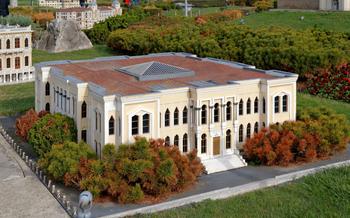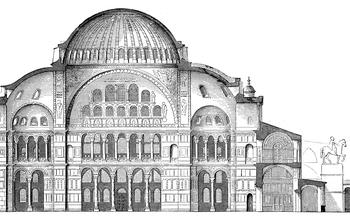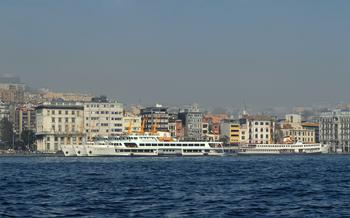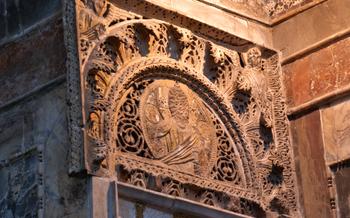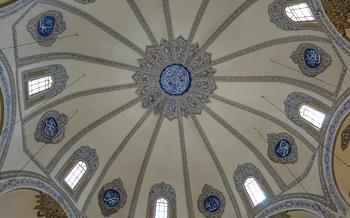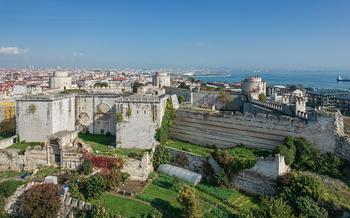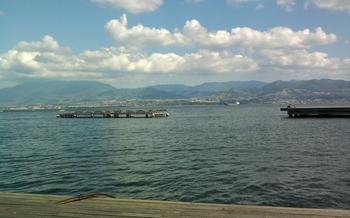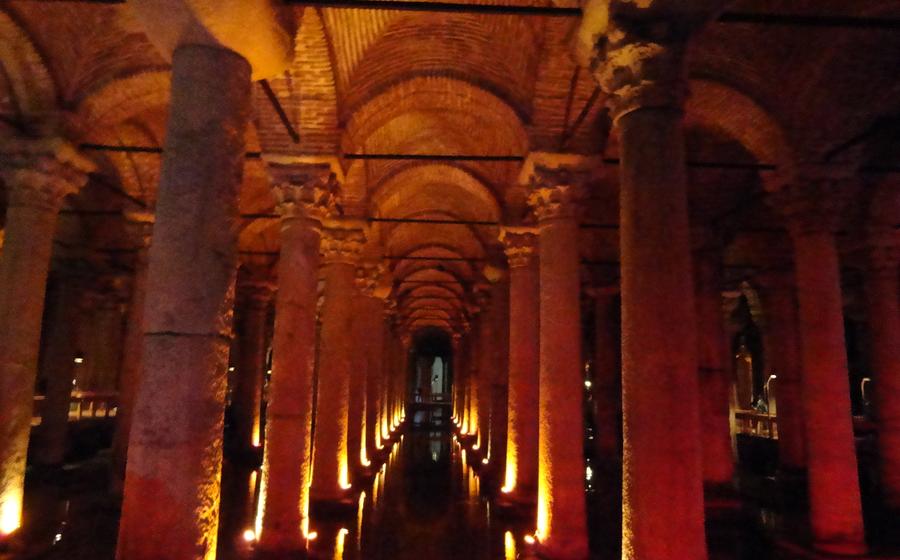
Basilica Cistern (Yerebatan Sarnici)
- A Journey to the Sunken Palace
- Stepping into History
- An Architectural Marvel
- Engineering Ingenuity
- A Place of Legends
- A Path through Time
- A Sensory Experience
- A Photographer's Paradise
- A Cinematic Masterpiece
- A Must-See for History Buffs
- A Unique Venue
- A Place of Reflection
- A Hidden Gem
- Practical Tips for Visitors
- Insider Tip: Unveiling Hidden Treasures
A Journey to the Sunken Palace
Described as an awe-inspiring subterranean marvel, the Basilica Cistern (Yerebatan Sarnici) in Istanbul, Turkey, invites you on an extraordinary journey back in time. Constructed during the Byzantine era in the 6th century, this remarkable cistern served as a vital water reservoir for the city. Its captivating history and architectural grandeur make it a must-see attraction for travelers seeking a glimpse into Istanbul's rich past.
Unveiling its secrets, the Basilica Cistern stands as a testament to the engineering prowess of the Byzantine Empire. Its vast dimensions, intricate columns, and mesmerizing arches create an otherworldly atmosphere that transports visitors to a bygone era. As you explore this subterranean labyrinth, you'll discover the ancient water system that once supplied life to the city, providing a glimpse into the ingenuity of Byzantine engineers.
Frequently asked questions about the Basilica Cistern often revolve around its purpose, construction, and significance. It served as a crucial water storage facility, collecting and distributing water to the imperial palaces, public baths, and residences throughout Istanbul. Its construction was commissioned by Emperor Justinian I, who sought to ensure a reliable water supply for the city's growing population.
Prepare to be captivated by the Basilica Cistern, a hidden gem that offers a unique and unforgettable experience for travelers seeking a blend of history, architecture, and engineering marvels.
Stepping into History
During the reign of Emperor Justinian in the 6th century AD, the Byzantine Empire embarked on an ambitious project to construct an underground cistern to address the city's growing water needs. The Basilica Cistern, also known as Yerebatan Sarnici in Turkish, was born out of this vision.
Justinian's vision extended beyond mere functionality; he sought to create a structure that would showcase the empire's architectural prowess and engineering ingenuity. The cistern was strategically positioned to collect and store water from the nearby aqueducts, ensuring a reliable water supply for the imperial palace, public baths, and other vital city installations.
Over the centuries, the Basilica Cistern played a crucial role in sustaining the city's water infrastructure. It served as a lifeline for Constantinople, the capital of the Byzantine Empire, and later for Istanbul under Ottoman rule. The cistern's remarkable resilience and ability to withstand the test of time bear testament to the exceptional engineering skills of the Byzantine era.
An Architectural Marvel
The Basilica Cistern stuns visitors with its sheer size, spanning an impressive 140 meters in length and 70 meters in width. Its vaulted ceiling, supported by 336 massive columns arranged in 12 rows, creates a breathtaking sense of space and grandeur. Each column, measuring 9 meters in height and 4 meters in circumference, is a testament to the engineering prowess of its builders. The intricate carvings and decorations adorning the capitals and bases of the columns add an artistic touch to the cistern's otherwise austere interior. The harmonious blend of Roman and Byzantine architectural styles is evident throughout, showcasing the diverse influences that shaped Istanbul's rich history.
Engineering Ingenuity
The Basilica Cistern showcases the remarkable engineering prowess of the Byzantine era. Constructed using innovative techniques, the cistern's design ensured a reliable water supply to the city. Its vaulted ceilings, supported by 336 marble columns arranged in 12 rows, demonstrate the mastery of structural engineering. These columns, some of which were repurposed from ancient temples, stand 9 meters tall, creating a mesmerizing forest of stone.
The water filtration system employed in the cistern was equally impressive. Water from the Belgrade Forest, collected in aqueducts, flowed into a settling tank before entering the cistern. This process removed sediment and impurities, ensuring the water's purity.
The cistern's resilience is a testament to the engineers' foresight. Built to withstand earthquakes, the cistern's sturdy construction has enabled it to survive numerous seismic events throughout history. Its ingenious design, combined with the high-quality materials used, has ensured its longevity.
The Basilica Cistern stands as a testament to the brilliance and ingenuity of Byzantine engineers. Their innovative solutions to water management and structural stability have left a lasting legacy, inspiring modern engineers and architects worldwide.
A Place of Legends
The Basilica Cistern is not just a marvel of engineering but also a place steeped in legends and folklore. The most captivating of these is the tale of the Medusa heads. Two of the cistern's columns are adorned with the severed heads of the mythical creature, their petrifying gaze turned downwards to prevent them from turning anyone to stone. According to legend, these heads were brought to the cistern from a pagan temple and placed upside down as a symbol of Christianity's triumph over paganism.
Another intriguing legend associated with the cistern is its connection to the lost city of Atlantis. Some believe that the cistern was part of a vast network of underground tunnels and chambers that once connected Istanbul to the legendary sunken city. While there is no concrete evidence to support this claim, it adds an air of mystery and intrigue to the cistern's already fascinating history.
Over the centuries, the cistern has also served as a backdrop for numerous stories and tales. It is said that during the Ottoman era, the cistern was used as a secret meeting place for dissidents and revolutionaries. The cistern's dark and secluded corners provided a safe haven for those plotting against the sultan's rule.
In recent times, the cistern has captured the imagination of popular culture. It has been featured in numerous films and TV shows, including the James Bond movie "From Russia with Love" and the popular Turkish TV series "Magnificent Century." These cinematic portrayals have further cemented the cistern's status as a symbol of Istanbul's rich history and captivating allure.
A Path through Time
Over the centuries, the Basilica Cistern has undergone various transformations, adapting to the changing needs of Istanbul. In the Ottoman era, it served as a storage facility for various goods, including olive oil, cheese, and caviar. During the 19th century, it was transformed into a fish market, where locals could purchase fresh seafood. In the 1980s, the cistern underwent extensive restoration and was opened to the public as a tourist attraction. Today, it continues to captivate visitors with its historical charm, while also serving as a unique venue for concerts, exhibitions, and fashion shows.
Despite the changes it has undergone, the Basilica Cistern remains a testament to the ingenuity and resilience of Byzantine engineering. The restoration efforts have successfully preserved its original features, allowing visitors to witness the grandeur and marvel of this ancient masterpiece. As you explore the cistern, take a moment to reflect on its rich history and the countless stories it holds within its walls.
A Sensory Experience
Prepare to be transported to another era as you step into the Basilica Cistern. The play of light and shadow creates an ethereal ambiance, with the water's surface reflecting the intricate carvings and arches. The acoustics within the cistern are equally captivating, with whispers echoing through the vast space. The cool, humid air adds to the sensory experience, creating a distinct atmosphere that transports visitors back in time. It's easy to imagine the bustling activity that once took place within these walls, as water flowed through the channels and people went about their daily lives. The Basilica Cistern offers a truly immersive experience that engages all the senses, leaving a lasting impression on visitors.
A Photographer's Paradise
The Basilica Cistern offers a feast for the eyes of any photographer, capturing its grandeur and intricate details. With natural light streaming in through openings in the ceiling, the play of light and shadow creates captivating compositions. Experiment with different angles and perspectives to showcase the rows of columns, the vaulted ceilings, and the intricate carvings. The serene atmosphere and lack of crowds provide the perfect conditions for capturing stunning shots without distractions. Share your photographic journey on social media using relevant hashtags to inspire others to explore this hidden gem. Remember to respect the rules and regulations regarding photography to preserve the cistern's beauty for future generations.
A Cinematic Masterpiece
The Basilica Cistern has captivated the imaginations of filmmakers and television producers, serving as a stunning backdrop for numerous productions. Its grand scale, intricate architecture, and atmospheric ambiance have made it a popular choice for historical dramas, fantasy films, and even music videos.
One of the most famous appearances of the cistern was in the 1963 James Bond film, From Russia with Love. The cistern's eerie and mysterious atmosphere provided the perfect setting for a dramatic fight scene between Bond and his nemesis, Red Grant.
More recently, the cistern was featured in the popular Turkish television series, Muhteşem Yüzyıl (Magnificent Century). The series, which tells the story of the Ottoman Empire during the reign of Sultan Süleyman the Magnificent, used the cistern to recreate the grandeur of the Byzantine era.
The cistern's cinematic appeal lies in its ability to transport viewers to another time and place. Its unique setting and historical significance make it a powerful tool for storytelling, allowing filmmakers to create immersive and memorable experiences for their audiences.
A Must-See for History Buffs
For history enthusiasts, the Basilica Cistern holds immense significance. It offers a tangible connection to Byzantine history, allowing visitors to step back in time and witness the grandeur of this ancient civilization. Through its well-preserved architecture, the cistern unveils the lives and stories of its builders, showcasing their ingenuity and craftsmanship. Exploring the cistern provides insights into Istanbul's water management system, revealing the advanced engineering techniques employed by the Byzantines to ensure a reliable water supply for their city. Overall, the Basilica Cistern serves as a living testament to the rich history and cultural heritage of Istanbul, captivating visitors with its historical significance and providing a deeper understanding of the Byzantine era.
A Unique Venue
The Basilica Cistern has undergone a remarkable transformation, evolving from a functional water reservoir to a captivating event space. Its unique ambiance and historical significance have made it a sought-after venue for a variety of events, ranging from concerts and exhibitions to fashion shows.
Imagine attending a classical music concert amidst the towering columns and echoing acoustics of the cistern. The harmonious blend of music and architecture creates a magical and unforgettable atmosphere, transporting attendees to another era.
The cistern's versatility extends beyond concerts. Art exhibitions find a perfect backdrop within its ancient walls, where contemporary works dialogue with the historical surroundings. Fashion shows take on a new dimension as models glide amidst the pillars, showcasing the latest creations against a backdrop of Byzantine grandeur.
Hosting an event at the Basilica Cistern offers a unique and immersive experience. It's an opportunity to blend history with modern experiences, creating a lasting impression on guests. Whether it's a corporate gathering, a private celebration, or a cultural event, the cistern provides an exceptional setting that is sure to captivate and inspire.
A Place of Reflection
Beyond its historical significance and architectural wonders, the Basilica Cistern holds a unique allure as a place of reflection and introspection. Its serene and contemplative ambiance, bathed in the soft glow of ambient light, invites visitors to pause, reflect, and connect with their inner selves. The echoing acoustics and the gentle sound of dripping water create a calming atmosphere, conducive to self-discovery and meditation. Within the ancient walls of the cistern, one can find solace and inspiration, allowing their thoughts and emotions to flow freely. It is a place where time seems to stand still, encouraging visitors to embrace the present moment and reflect on their own lives and journeys.
A Hidden Gem
Nestled amidst the bustling streets of Istanbul, the Basilica Cistern lies as a hidden gem, waiting to be discovered by discerning travelers. Unlike other renowned attractions that draw throngs of tourists, this subterranean marvel offers a respite from the crowds, allowing visitors to immerse themselves in its serene and contemplative atmosphere.
Straying from the beaten path, travelers will find the cistern tucked away near the Hagia Sophia and Topkapi Palace, two of Istanbul's most iconic landmarks. Its inconspicuous entrance, often overlooked by hurried tourists, adds to its allure as a hidden treasure.
Stepping inside the cistern is like entering a secret chamber, where time seems to stand still. The absence of overwhelming crowds allows visitors to fully appreciate the cistern's grandeur, its intricate columns, and the mesmerizing play of light and shadow.
This hidden gem offers a unique opportunity for travelers to connect with Istanbul's rich history and culture without the distractions of mass tourism. It is a place where one can wander freely, marvel at the architectural wonders, and soak in the tranquility of this subterranean sanctuary.
Practical Tips for Visitors
To make the most of your visit to the Basilica Cistern, consider these helpful tips:
-
Plan Your Visit: Check the official website for opening hours and ticket prices. Advance booking is recommended during peak season to avoid queues.
-
Timing is Key: Visit early in the morning or late in the afternoon to avoid the crowds and enjoy a more intimate experience.
-
Explore the Area: Combine your visit with other nearby attractions such as the Hagia Sophia, Topkapi Palace, and the Blue Mosque.
-
Respect the History: Remember that the Basilica Cistern is a historical site. Be mindful of your behavior and avoid touching or damaging any of the structures.
-
Photography Etiquette: While photography is allowed, use flash photography responsibly to avoid disturbing other visitors.
-
Comfortable Footwear: The cistern's floors can be slippery, so wear comfortable, non-slip shoes.
-
Audio Guides: Enhance your experience by renting an audio guide to learn more about the history and significance of the cistern.
Insider Tip: Unveiling Hidden Treasures
Beyond the awe-inspiring grandeur of the Basilica Cistern, there lies a secret spot that offers a unique perspective to discerning travelers. Tucked away in a secluded corner, this hidden gem reveals intricate carvings and details that often go unnoticed by the casual visitor. Discover the enigmatic symbols etched into the stone, each holding a story waiting to be deciphered. Share this insider knowledge with fellow travelers and create a memorable and enriching experience that goes beyond the ordinary. Immerse yourself in the cistern's mystique and uncover its hidden treasures, leaving you with a deeper appreciation for its historical significance.

